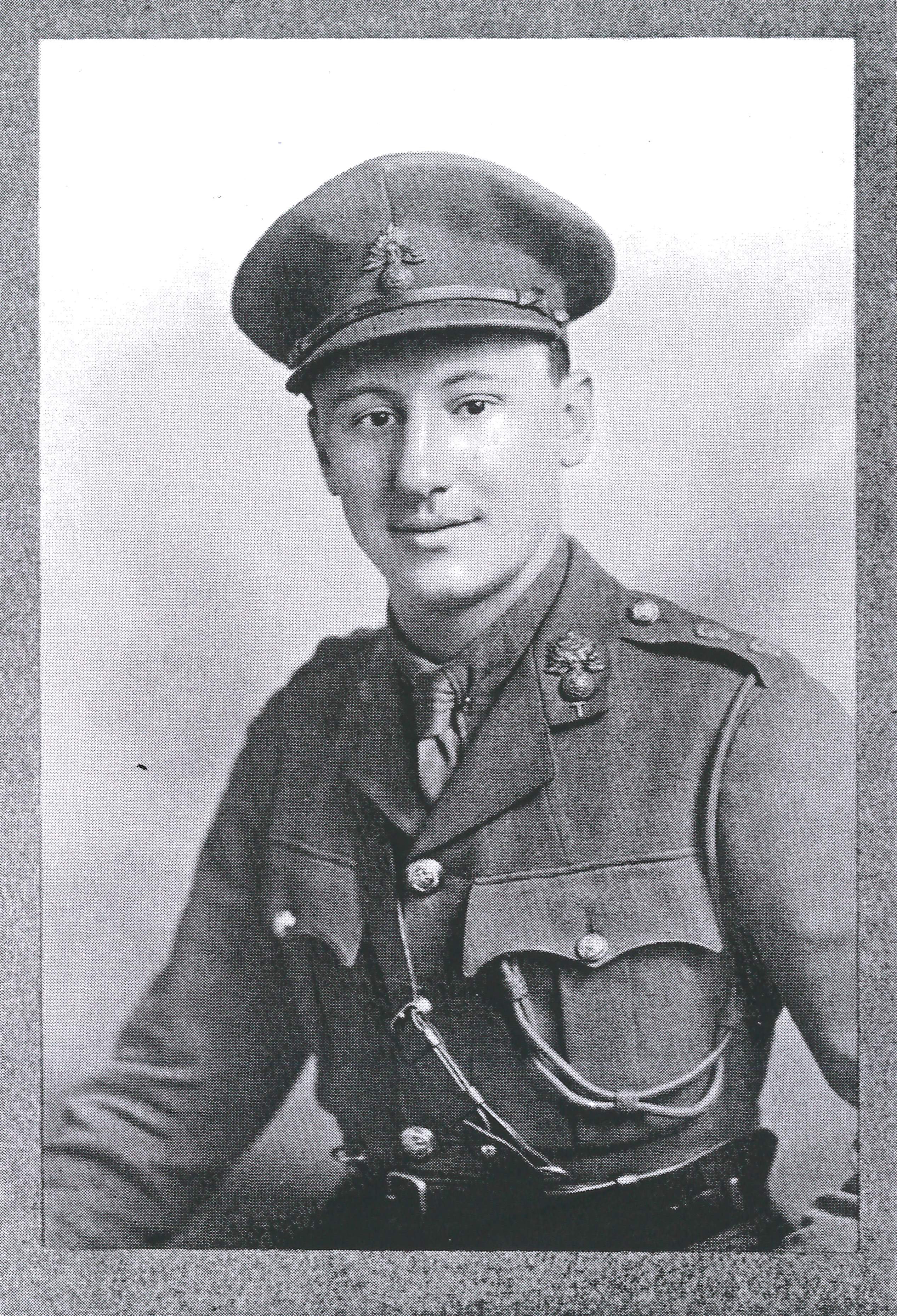Capt
Richard Victor Joseph Roy Agius
Informatie over geboorte
|
Geboortedatum: 19/09/1896 |
|
Geboorteplaats: Hampstead, Middlesex, Engeland, Verenigd Koninkrijk |
Algemene Informatie
|
Beroep: Student |
Informatie legerdienst
|
Land: Engeland, Verenigd Koninkrijk |
|
Strijdmacht: British Expeditionary Force |
|
Rang: Captain |
|
Service nummer: / |
|
Dienstneming datum: 07/09/1914 |
|
Eenheden: — Royal Fusiliers (City of London) Regiment, 2/3rd Bn. (Laatst gekende eenheid) |
Informatie over overlijden
|
Datum van overlijden: 26/10/1917 |
|
Plaats van overlijden: Helles House, Poelkapelle, België |
|
Doodsoorzaak: Killed in action (K.I.A.) |
|
Leeftijd: 21 |
Gedenkplaats
|
Tyne Cot Memorial Paneel: 149.A |
Onderscheidingen en medailles 3
|
1914-15 Star Medaille |
|
British War Medal Medaille |
|
Victory Medal Medaille |
Points of interest 1
| #1 | Geboorteplaats |
Mijn verhaal
Captain Agius Richard Victor Joseph Roy, nicknamed by friends and family as “Dickie”, served in the Londen Regiment (Royal Fusiliers), 2nd/3rd Battalion, part of the 173rd (3/1st London) Brigade, of the 58th (2/1st London) Division. On the 26th of October 1917 the Division participated in the Second Battle of Passchendaele, the last phase of the Third Battle of Ypres. The Division advanced to the east of Poelcapelle, with the 173rd Brigade. The Brigade attacked with the 2nd/2nd and 2nd/3rd London; the 2nd/4th London were in support and the 2nd/1st were in reserve. At 5.40 a.m., zero hour, the 2nd/2nd and 2nd/3rd London advanced from their positions at the eastern outskirts of Poelcapelle. The 2nd/2nd on the right set off to Cameron house, where it captured three German blockhouses. On the left flank the 2nd/3rd London advanced towards Spider Cross Roads. Owing to the muddy condition of the ground the progress of the Battalion was very slow. Therefore the men were unable to keep up with the creeping artillery barrage. On top of the ghastly condition of the terrain the Battalion was held up at several points by German machine gun- and rifle fire. Notwithstanding all these difficulties the attacking parties kept on advancing to the northeast of Poelcapelle, capturing several prisoners on the way. The 2nd/3rd London even managed to advance to points near Spider Cross Roads, where they were finally checked by heavy machine gun fire. Between 7 and 10 a.m. the men were forced to withdraw, due to a large German counter attack on Cameron House. With their right flank up in the air and in danger of being cut off, the 2nd/3rd London had no choice but to fall back. At the end of the day the whole 58th Division had been driven back to positions near their original line. Losses were huge in the 2nd/3rd London, especially among the officers. The Battalion was relieved during the night. Captain Agius Richard Victor Joseph Roy was one of the officers who fell during the attack on Spider Cross Roads. It is said that Captain Agius was shot in the head and fell near Helles House. A penciled ‘x’ on a drawn map by two of his brothers show this location. His remains were never recovered or never identified. Possibly because after the Battalion withdrew. Captain Agius is remembered on Tyne Cot Memorial.
At the start of August 1914 brothers Alfred and Arthur were already in uniform, as officers in the Third London Regiment, Territorial Force, and Edgar was soon to follow. Tancred, by then a young Monk at Downside Abbey,completed his training for ordination and went on to serve as a Chaplain to the B.E.F. in 1917 – 1918. All four brothers saw service on the Western Front and survived the war, despite being wounded. They were mentioned in despatches and two won an M.C. Richard, the youngest of the family, completed his studies at Downside in July 1914, aged 17. In September he turned 18 and lost no time in obtaining a Commission in the London Regiment. He saw his first action at Gallipoli (Suvla Bay), and eventually joined his brothers on the Western Front in spring 1917. Had he survived the war it was his intention to become a monk at Downside Abbey.
At the start of August 1914 brothers Alfred and Arthur were already in uniform, as officers in the Third London Regiment, Territorial Force, and Edgar was soon to follow. Tancred, by then a young Monk at Downside Abbey,completed his training for ordination and went on to serve as a Chaplain to the B.E.F. in 1917 – 1918. All four brothers saw service on the Western Front and survived the war, despite being wounded. They were mentioned in despatches and two won an M.C. Richard, the youngest of the family, completed his studies at Downside in July 1914, aged 17. In September he turned 18 and lost no time in obtaining a Commission in the London Regiment. He saw his first action at Gallipoli (Suvla Bay), and eventually joined his brothers on the Western Front in spring 1917. Had he survived the war it was his intention to become a monk at Downside Abbey.
Bronnen 4
|
Agius WorldWar1 http://agiusww1.com/ Gebruikte bronnen |
|
Graham L., Downside and the War 1914 -1919 ", (Uckfield, The Naval & Military Press Ltd., 1925). Gebruikte bronnen |
|
Grey W.E., The 2nd City of London Regiment (Royal Fusiliers) in the Great War 1914-19, (London, The Headquarters of the Regiment, 1929). Gebruikte bronnen |
|
McCarthy C., The Third Ypres Passchendaele. The Day-by-Day Account, (London, Arms & Armour Press, 1995). Gebruikte bronnen |
Meer informatie 3
|
Commonwealth War Graves Commission Database https://www.cwgc.org/find-records/find-war-dead/casualty-details/845753 |
|
Namenlijst (In Flanders Fields Museum) https://namenlijst.org/publicsearch/#/person/_id=bd52a311-74ee-41d9-ab51-a4a4ac4706bd |
|
Lives of the First World War (Imperial War Museum) https://livesofthefirstworldwar.iwm.org.uk/lifestory/659232 |
